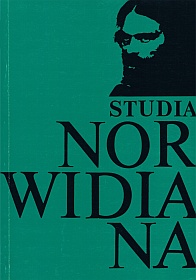Cyprian Norwid’s Caricatures
Abstract
Cyprian Norwid the master artist still is not known well enough, although his artistic output, of uneven value, includes some remarkable pieces. Among them are his caricatures.
Norwid practised caricature throughout his life. Already in his school years he demonstrated an ability to execute humorous miniature portraits of his friends and other people he knew. Only very few of those early caricatures remain. We have a much larger collection of Norwid's caricatures from the late 1840s. He made them during his studies and journeys in Europe, putting them next to his other sketches and notes in the special personal albums he kept or leaving them in the then fashionable albums and sketchbooks belonging to the owners of the salons he frequented. Those early works, like the few we know of the 1850s, were mostly incidental and were chiefly portrait caricatures. The speed and facility with which he executed such drawings were the reason that Norwid did not take that part of his work very seriously. It was only starting from the late 1860s, perhaps as a result of the growth of the genre in Poland (contacts with J. Kossak and W. Gerson), that Norwid turned towards caricature fully purposely, making it a major part of his work as a graphic artist for many years to come.
The collection of the caricature compositions of the last several years of Norwid's life gives us the best idea of the artist's potential and achievement as regards that form of expression. The fairly wide thematic range of the collection is best described as social and moral. The caricature usually has as its target the local émigré milieu or situations and phenomena typical of the Polish landed gentry. Among Norwid's most interesting pieces are the caricatures from the cycle of several drawing he presented, after the year 1873, to Mr and Mrs Józef Wagner or to their son-in-law Mieczysław Geniusz. They include “political” caricatures (“A Meeting of Emigrés”, “A Dispute”, “An Altercation”) very aptly capturing Polish émigré types and the disputes in the émigré circles in Paris at the time, caricatures that depict social and family life (“The Proposal”, “A Quarrel”, “A Family Incident”), and works whose dominant hero is the figure of the portly Polish nobleman, the prototype of which can be found in Norwid's “Traveller's Diary” of 1867. Among other caricatures of the 1870s there are a few striking satirical drawings on the subject of the condition of art and the position of the artist in the days of the growth of capitalism (“The Modern Polemic”, “The 19th Century Muse”, “A Concert”, “Art and the Burgher”, “The Pygmalion of the 19th Century”). The fine arts are dealt with in a set of three caricatures of 1877 which could be called “The Polish Nobleman as a Patron”. Together with the earlier drawings depicting the events described in the “Traveller's Diary”, these three form a cycle that presents the Polish gentry's attitude towards literature, music,
painting, sculpture and architecture. Norwid does not treat his nobleman-landowner type with much kindness. He models his hero's physiognomy on the old-Polish nobleman figure, but does not idealize his character as many caricaturists active in Poland were doing; indeed, he speaks up sharply and decisively against the nobility's mentality and mores. Norwid often supplemented his caricatures with a commentary. His best piece of this kind, where caricature drawings are in perfect harmony with the sombre tone and ironic seriousness of the verbal account, is the humorous sketch of 1877 “Klara Nagnioszowska Commits Suicide”.
The collection of Norwid's last caricatures is also an excellent showpiece for his stylistic achievement as a draughtsman. Their perfect expression is attained through the combination of a firmly drawn line with obvious creative freedom; the result is an impression of directness and sincerity. The supple and intricate but smoothly curving line and the expressiveness and simplicity of approach justify a comparison of the style and form of some of Norwid's works to certain sketches by Daumier, the greatest master of the genre. The originality and thoroughly individual imagery of Norwid's caricatures places him among Poland's most outstanding caricaturists.
Copyright (c) 1991-1992 Studia Norwidiana

This work is licensed under a Creative Commons Attribution-NonCommercial-NoDerivatives 4.0 International License.





